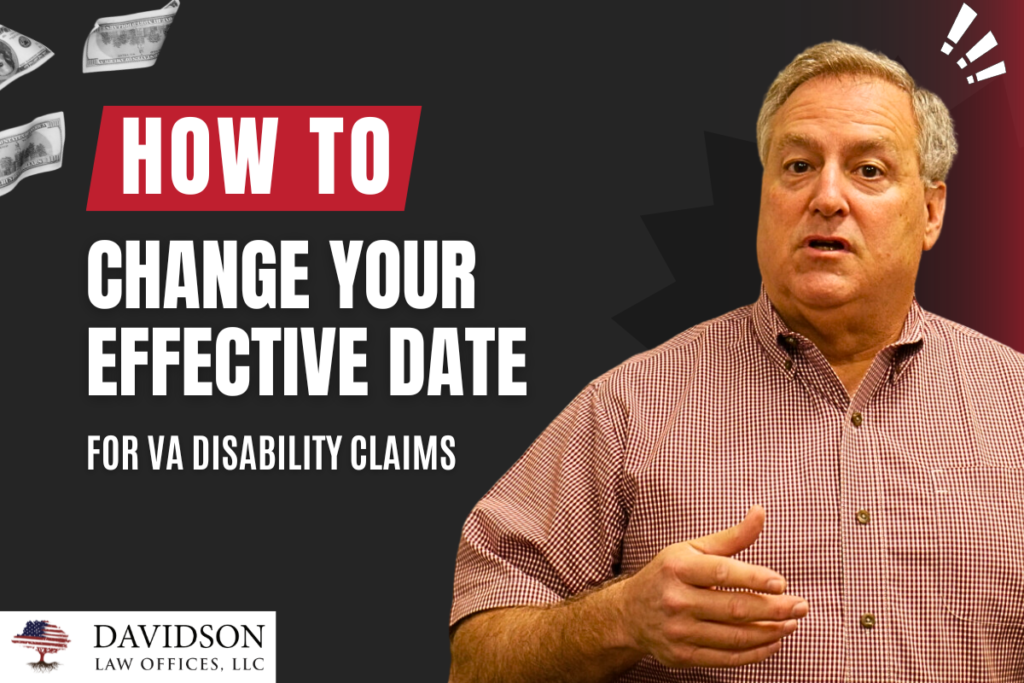Did you know you could get more disability compensation from the VA by changing the effective date of your claim? Here we’ll explain how to obtain an earlier effective date under non-PACT Act rules. We’ve done several PACT Act blogs over the last couple years, but here we’re talking about non-PACT Act rules.
Getting an Effective Date Prior to the PACT Act
When service connection is granted for a presumptive condition listed under the PACT Act, normally there is a change in statute or regulation that creates an entitlement under the VA disability benefit rules. As a claimant, you’re then entitled to VA benefits based upon that change. Usually that entitlement is granted no earlier than the effective date of the rule change or statute.
The PACT Act was signed into law on August 10, 2022. So if your condition was on that presumptive list for the PACT Act, your effective date would be August 10, 2022. But we can sometimes get an effective date earlier than the PACT Act, putting more money in your pocket.
Let’s say you had a claim for service connected disability pending before the PACT Act was signed into law. And once the PACT Act was finalized, the VA granted your claim based on the new presumptions listed in the PACT Act. That means your effective date would be no earlier than Aug 10, 2022. But there is a way to correct that and get an effective date prior to that PACT Act date.
To do this, you must establish service connection (aka nexus) for your disease or injury prior to the date of the law change. Proving nexus is easy if you have one of the presumptive conditions defined by the VA. But if you don’t have those presumptions, there are more hurdles you must jump.
Iraq Burn Pit Example
Let’s say that you served in Iraq in 2008. And because you served in 2008 you are considered a “covered Veteran.” In 2020 you developed a condition as a result of burn pit exposure in Iraq during your service. In Feb 2021, you filed a claim with the VA for a service connected disability, arguing that you were exposed to toxins in Iraq.
The VA regional office denies your claim initially, but you appeal. During the appeals process, the PACT Act is signed into law and now you have the presumption to help with your claim. The VA would now grant your disability benefits based upon the PACT Act. But if we can prove your service connected disability without the PACT Act, we can get an earlier effective date and more money for you.
To get that earlier effective date, you’ll need to convince the VA that you’re entitled to service connected disability prior to the PACT Act. You have to show that your claim already satisfies all the elements necessary for service connection, even without the PACT Act law changes. You need a medical opinion that supports the idea that your exposure to toxic fumes in Iraq caused your disability or condition.
In this particular case, getting an earlier effective date would mean 16-18 months of additional disability compensation. That’s a big chunk of change that you’re leaving on the table if you don’t argue direct service connection prior to the PACT Act. This is why we always try to establish entitlement to service connection under the old rules. It doesn’t always work, but we always try.
Asthma Example
Let me give you another example. Assume that you pursued a claim for asthma since filling back in Jan 2022. And I’m going to assume that in March 2023, the VA issued a decision on your claim. Now if your claim can be granted under the Aug 2021 regulations, you’d be entitled to an effective date of Aug 2021 — the date the regulation for the old asthma presumption went into effect.
But if your claim can’t be granted under the old regulations, then we go under the new regulations — the PACT Act, which is Aug 2022. So you can see dealing with these regulations, it really is rocket science. We want to maximize the benefits to our Veterans and their spouses, so we’re going to look to see exactly what can we do to get the earliest effective date as possible. Sometimes it’s not always possible, but we try.
What If You Don’t Have a Presumptive Condition?
Maybe you’re a covered Veteran, but don’t qualify for presumption of service connection. Can you still use the presumption of exposure in the PACT Act to obtain a favorable medical opinion? Absolutely you can! I’m a firm believer of providing strong medical evidence for every VA disability claim, even if you have the presumption. But if you don’t have the presumption, this strong medical evidence is going to help you get your claim approved.
In other words, you can still use the PACT Act to your advantage even though your condition is not on the presumptive list. We have to work harder to prove the service connection, but we can use the toxic exposure information in the PACT Act to help. The PACT Act tells us where certain toxic exposures occurred and how those caused certain diseases and disabilities. If we can connect those listed toxic exposures to your specific condition, we have the service connection you need to get your claim granted.
We suggest that you give your doctor a list of toxic substances, chemicals, airborne hazards, etc., to which you were exposed. Also give your medical provider a list of the toxic chemicals under the PACT Act for which the presumptions arise. Your doctor can then help you establish service connection for the non-presumptive condition.
If you have medical literature showing a relationship between your disability and the toxins listed in the PACT Act, be sure to give that to your doctor. This type of evidence is invaluable. It’s even better if you can get your doctor to cite some of these reports in their medical opinion.
I know it’s tough to get doctors to take the time to do all this, but you can assist them as much as possible. Give them all the information and medical research you can find, and have a candid conversation with them about your situation. Ask them to put all this evidence into their own words so that you can have a strong case for your VA disability claim.
Contact Us So We Can Help!
If you need assistance with VA disability benefits, complete this form or give us a call at (229) 226-8183. If you’d like to see this blog in video format, you can watch it below. Please be sure to SUBSCRIBE to our YouTube channel and click the bell notification button so that you’re notified each time we publish a new video.

